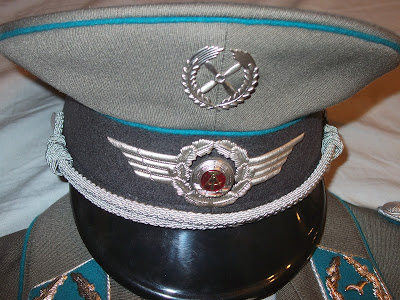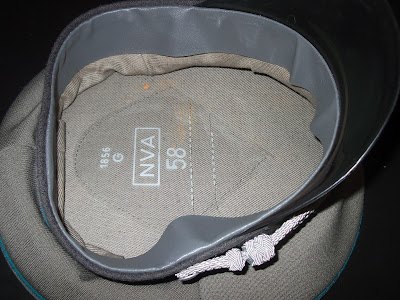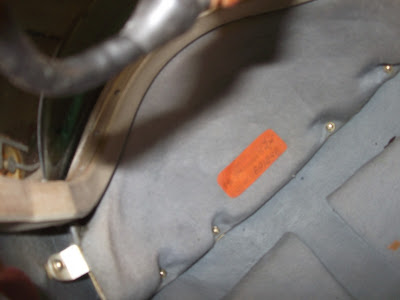The Luftstreitkräfte or LSK was the name adopted by the East German Air Force upon it's establishment in 1956. The original Luftstreitkräfte was the air corps of the German Imperial Flying Corps which operated from 1910 through the end of the First World War in 1918. With the West German Air Force retaining the name Luftwaffe upon it's inception, the East German's absorbed the title of Luftstreitkräfte. In March of 1956 the Air Force was officially established as part of the National Volksarmee, following East Germany's entry into the Warsaw Pact alliance. Initially the Air Force (LSK), with its headquarters at Cottbus, was separate from the Luftverteidigung (Air Defense) which was headquartered at Strausberg (Eggersdorf). It was intended to establish three fighter divisions, an attack aircraft division and an anti-aircraft division. However, eventually only the 1st and 3rd Aviation Divisions and the 1st Flak-Division were created. In June of 1957 the Luftstreitkräfte and the Luftverteidigung were realigned under a single administration in Strausberg (Eggersdorf), as Kommando LSK/LV.
The East German Air Force was unique among Warsaw Pact countries in that it was often equipped with the most advanced Soviet fighters, instead of downgraded export models. As an extension of the Soviet 16th Air Army deployed in East Germany, the Luftstreitkräfte was expected to play a front-line role in any war with NATO. As a result, it was under closer Soviet control than the air forces of other Warsaw Pact nations. Most aircraft were of Soviet origin with a number of trainers purchased from Czechoslovakia. The Air Force's primary mission eas to prevent hostile penetration of East German airspace by foreign entities. The secondary role of the Luftstreitkräfte was supporting the Landstreitkräfte (Ground Forces) and in fulfilling this mission, the LSK operated an extensive number of combat helicopters primarily the Mi-8 Hip utility helicopter in both unarmed and armed versions and the Mi-24 Hind D gunship.
 |
| National insignia of East Germany as it appeared on the side of East German Air Force equipment |
The LSK maintained a personnel strength of 39,000 troops, of about which 38% were draftees (higher ratio of officers and NCOs to enlisted than any other branch of the NVA). It maintained nearly 700 combat aircraft, including MiG-23 Flogger fighter bombers, MiG-21 Fishbed interceptors, the sophisticated MiG-29 Fulcrum interceptor, and Su-22 Fitter ground attack aircraft. Following an older German tradition, LSK/LV uniforms were the same stone gray worn by army personnel, modified by distinctive blue insignia which were similar in style, but not color, to Luftwaffe insignia of the Second World War and piping.
Upon reunification, to commemorate the last official flight of the East German Air Force, a special color scheme was applied to a Mikoyan-Gurevich MiG-29 Fulcrum of JG3 Vladimir Komarow stationed at Preschen and flown on September 27, 1990. This color scheme was only used once and this specially painted aircraft was named die Traditionsmaschine (the Traditional Aircraft).


The uniform displayed here shows Dienstuniform (Service Uniform) of an Oberstleutnant (Lieutenant Colonel) in the Luftstreitkräfte / Luftverteidigung (Air Force/Air Defense Forces).The uniform is made of the distinctive stone grey gabardine material and bears a lot of similarities to it's Army counterparts. Note the blue waffenfarbe piping signifying the Air Force.






The visor cap shown here for a Luftstreitkräfte officer in the stone grey color of National Volksarmee uniforms along with its associated blue piping. Note the version of the national roundel insignia worn by the Air Force with the hammer and compass logo surrounded by a wreath and wings. Also to note and which differentiates visor caps worn by the Luftstreitkräfte from the Luftverteidigung is the propeller insignia above the national insignia. The propeller insignia was not worn by Air Defense Troops.
Note the interior marking of NVA for the East German National Volksarmee. This visor example shown here carries a letter 'G' designation meaning the visor was manufactured in 1981. The number beneath the NVA stamp represents the size of the hat in centimeters, this example is 58cm or roughly 7¼in by American sizing equivalents.
Here's a close up view of the national insignia worn by the Air Force/Air Defense Forces.
Here's a close up view of the propeller and wreath insignia of the Air Force.
 |
| World War II Nazi Luftwaffe officer collar tabs 1933-1945 |
Shown here is the Kragenspiegeln (Collar Insignia) of an LSK/LV officer. It is similar to the World War II Luftwaffe style collar tabs worn by officers except here it is a single pair of silver wings surrounded by a wreath against a blue background significant of the Air Force/Air Defense Forces. It also retains the blue piping of the LSK/LV.
Shown here is a close up of the shoulderboard insignia for an Oberstleutnant (Lieutenant Colonel) in the Luftstreitkräfte / Luftverteidigung with the silver officer braiding and two gold pips of a senior officer against the blue backing of the LSK/LV.
The Luftstreitkräfte / Luftverteidigung blue waffenfarbe piping around the sleeves of the service tunic.
Displayed here is the gray dress shirt issued to regular soldiers in the armed forces for wearing underneath the uniform tunic along with the dark grey NVA tie and the stone grey trousers worn by the Luftstreitkräfte / Luftverteidigung complete with the blue piping running down the length of the pant leg. On certain occasions the jacket could be removed and this variant of the uniform worn. All shirts in the East German government had loops on the shoulder for mounting rank shoulderboards when not wearing the jacket. In summer and warm climates, the tie could be removed and the shirt collar worn open.
The stone grey service trousers worn by NVA and Grenztruppen personnel, this distinguishing mark of Luftstreitkräfte / Luftverteidigung trousers being the blue waffenfarbe stripe running along the length of the pant leg as seen here.
Here's a shot of the interior tag of the pants displaying them as a size M-48. The M standing for Of Average Height and the 48 being equivalent to 33-36 in American waist equivalents.
Displayed here are the Luftstreitkräfte Flugzeug & Hubschrauberführer (Airplace & Helicopter Pilot) Klassifizierungsabzeichen (Classification Badges) in their three grades for Aviators with an East German fighter plane against a blue background in gold, surrounded by a pair of oak leaves and the East German coat of arms with a hammer and compass at the top and the number of class of the badge and essentially wings protruding from the ends of the central round. It would be worn on the right side of the uniform over the right breast pocket of the tunic.
Mikoyan Gurevich MiG-21 Fishbed in East German Luftstreitkräfte Service
Mikoyan Gurevich MiG-23 Flogger in East German Luftstreitkräfte Service
Mikoyan Gurevich MiG-29 Fulcrum in East German Luftstreitkräfte Service
Mil Mi-24 Hind D in East German Luftstreitkräfte Service









The GSH-6 was a high altitude helmet worn with aviator pressure suits primarily for operation with fighter interceptors from the MiG-21 Fishbed series onward. GSH-6's in service with the East German Air Force retained their Soviet markings and like almost all equipment of Soviet origin in East Germany they retained their Cyrillic markings.
The GSH-6 has 8 locking lugs. The visor on the GSH-6 series is electrically heated to keep it from fogging. It snaps down tightly onto a gasket surrounding the faceplate opening. The locking neck-ring with rubber gasket (two variants - one, a latex very light rubber, and the second, a much more rigid gray rubber for higher altitude flights) is an integral part of the GSH-6 as it couples up with the altitude compensation suit to provide the complete pressure package. The cloth inner helmet has the integrated communications package, (2 headphones & a boom microphone). The headphones are covered with soft lambskin.
The outer helmet does not have integrated communications, but it does have a T-shaped trench on the inside that hooks up with the soft cloth insert inner helmet. This helmet has a leather encased foam "T" that fits into the grooves on the inside of the helmet shell.




















